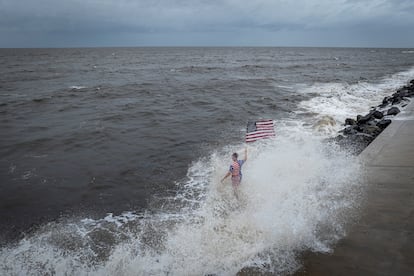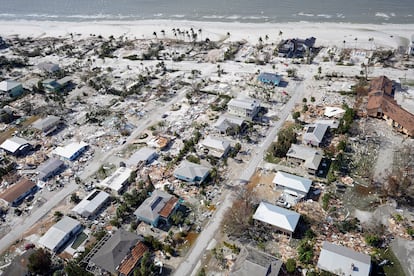Hurricane Helene makes landfall in Florida: How does it compare to Ian and Idalia?
The two previous hurricanes followed a similar path to the storm, which US authorities have described the storm as ‘extremely dangerous and life-threatening’

Hurricane Helene made landfall just after 11:00 p.m. (local time) in Florida as a Category 4 storm. After quickly strengthening from tropical storm to hurricane on Wednesday, Helene continues to produce “catastrophic winds,” warned the U.S. National Hurricane Center, which described the situation as “extremely dangerous and life-threatening.”
Florida Governor Ron DeSantis declared a state of emergency in Florida, as did the governor of Georgia and South Carolina. U.S. President Joe Biden warned Americans to take Hurricane Helene “extremely seriously.” On Thursday, he issued two emergency declarations for the states of Alabama and South Carolina. Authorities have asked citizens to remain in their homes or stay in the shelters that have been set up.
So far, one death was reported in Tampa after a highway sign hit a car, and two other people died due to the effects of a tornado in Georgia. Both events occurred before Helene made landfall on the Florida coast.
Florida is hurricane country, but even though hurricane season hits the south-east of the country every year, the winds and storm surges never fail to be terrifying and devastating. Comparisons are commonly used to understand the scale of the disaster. And there is a long history to draw from.
Amid the threat of Helene, meteorologists have reached back more than a century, citing the historic flooding of Asheville, North Carolina, in 1916 and the havoc wreaked by Hurricane Hugo in Charlotte, NC, in 1989 — relevant comparisons given Helene’s potential to severely impact inland areas. But there is no need to go that far back, more recent hurricanes are still fresh in people’s memories: Hurricane Ian in 2022 and Hurricane Idalia in 2023.
These two hurricanes followed relatively similar paths to Helene, moving from the Caribbean into the Gulf of Mexico, where they strengthened over the warming waters, before making landfall in Florida. At the time, Ian was at the third-costliest weather disaster in U.S. records, causing an estimated $113 billion in damages, and, killing 161 people — the highest death toll since the Labor Day hurricane of 1935. Beginning off the coast of West Africa, Ian crossed the tropical Atlantic and entered the Caribbean past Trinidad and Tobago. A few days later, it hit Cuba as a Category 3 hurricane, causing severe flooding and power outages nationwide.
Although Ian lost some strength after passing over the island, it quickly regained strength over the waters of the Gulf of Mexico, reaching Category 5 strength with sustained winds of 160 mph moments before making landfall in southwest Florida. Given this force, Ian tied several other storms to become the fifth-strongest hurricane on record to make landfall in the continental United States. After moving inland, it quickly weakened to a tropical storm before moving back out into the Atlantic. There it strengthened again into a hurricane before making landfall in South Carolina.

Idalia, on the other hand, had an even more similar path to Helene’s. It formed near the coast of Yucatán as a tropical storm, before entering the Gulf of Mexico where it quickly intensified, becoming a Category 4 hurricane before hitting the Big Bend region of Florida — precisely where Helene made landfall on Thursday night. As it moved north, Idalia remained a hurricane, as Helene is expected to do, until it crossed the border with Georgia, finally downgrading to a tropical storm as it entered the Carolinas.
Idalia caused significant damage to thousands of homes, businesses, and other infrastructure as it moved inland, primarily in Florida, which was the hardest hit by the winds and flooding. Its storm surge was record-breaking from the Big Bend region south to Tampa Bay. Roads in Tampa Bay were flooded and hundreds of cars were submerged. The system also triggered a tornado outbreak, with about 12 tornadoes confirmed in states north of Florida.
This year, the Caribbean hurricane season has been unusual. In June, Beryl became the earliest Category 5 storm on record, but August and September were unusually calm — despite Francine hitting the Louisiana coast. But now Helene is one of the largest storms ever recorded, at 420 miles (675 km) in diameter. This is different from strength, which is measured by the intensity of the winds at the epicenter.
Weather experts have pointed to unusually warm water in the Gulf of Mexico. Simply put, warmer water evaporates more easily, and the rising plumes of warm, moist air from that evaporation are what drive hurricanes and their rapid intensification.
Helene is threatening homes and lives across a triangle of the southern United States stretching from southern Florida, north along the coast of South Carolina, to eastern Arkansas. Hurricane-force winds are forecast for the Atlanta area, the sixth-most populous metropolitan area in the country, tornadoes are forecast for the Carolinas border area, and historic flooding is possible for virtually all of the southeastern states, especially along the triple border of Georgia, Tennessee and North Carolina.
Sign up for our weekly newsletter to get more English-language news coverage from EL PAÍS USA Edition
Tu suscripción se está usando en otro dispositivo
¿Quieres añadir otro usuario a tu suscripción?
Si continúas leyendo en este dispositivo, no se podrá leer en el otro.
FlechaTu suscripción se está usando en otro dispositivo y solo puedes acceder a EL PAÍS desde un dispositivo a la vez.
Si quieres compartir tu cuenta, cambia tu suscripción a la modalidad Premium, así podrás añadir otro usuario. Cada uno accederá con su propia cuenta de email, lo que os permitirá personalizar vuestra experiencia en EL PAÍS.
¿Tienes una suscripción de empresa? Accede aquí para contratar más cuentas.
En el caso de no saber quién está usando tu cuenta, te recomendamos cambiar tu contraseña aquí.
Si decides continuar compartiendo tu cuenta, este mensaje se mostrará en tu dispositivo y en el de la otra persona que está usando tu cuenta de forma indefinida, afectando a tu experiencia de lectura. Puedes consultar aquí los términos y condiciones de la suscripción digital.
More information
Archived In
Últimas noticias
Most viewed
- Reinhard Genzel, Nobel laureate in physics: ‘One-minute videos will never give you the truth’
- Oona Chaplin: ‘I told James Cameron that I was living in a treehouse and starting a permaculture project with a friend’
- Pablo Escobar’s hippos: A serious environmental problem, 40 years on
- Charles Dubouloz, mountaineering star, retires at 36 with a farewell tour inspired by Walter Bonatti
- Why we lost the habit of sleeping in two segments and how that changed our sense of time










































